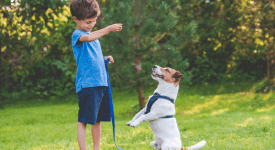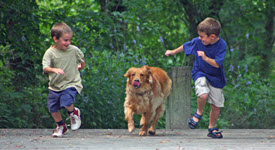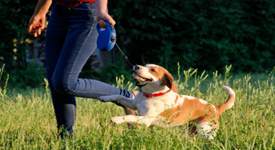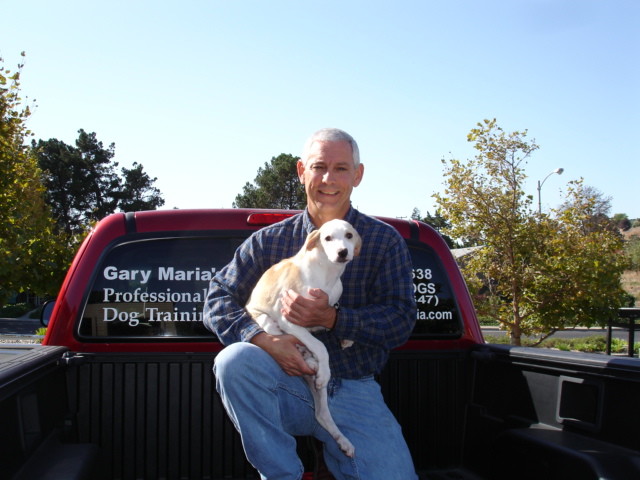In a few of my prior articles, I have written about dog pet owners accidentally giving mixed signals to their dog as part of poor training. I will tie this together below through a more detailed explanation of inconsistent handling.
Inconsistent handling of a dog refers to a lack of consistency in how an owner or handler interacts with a dog, trains, and manages a dog’s behavior.
What the dog understands from this is there isn’t a clear leader-follower relationship between you and it. This can make a dog become insecure or display many unwanted behaviors because the dog thinks he’s boss.
A common mistake for inconsistent handling is using two different verbal cues for the same behavior.
For example, an owner says both “sit” and “down” at different times and days, which mean two different things but both terms are used interchangeably for the same command.
This creates confusion for the dog and makes it harder for the dog to know what its’ owner or handler wants so it can deliver on the desired behavior – sitting. This point goes back to setting a clear expectation which ultimately gives your dog a job to do.
A second example is rewarding bad behavior without knowing it. This will reinforce this unwanted behavior with the dog in exchange for an award, like food.
A third common form of poor training is punishing a dog who is fearful or while the dog is in a state of fear. If a dog displays signs such as growling or hiding, they are trying to communicate. As humans, we don’t always pick up on these signals. Punishment can make things worse and bring out more fear and insecurity in a dog. Instead, provide a calm and secure environment and praise and reward the dog for calm behavior or when it shows bravery.
Forth, is a lack of consistency in reinforcment. To achieve consistent handling, there needs to be consistency in reinforcement of the desired behaviors along with repetition of a command across different scenarios and environments.
This combination of consistency in positive reinforcement with repetition of a command, teaches a dog that rules are not optional. This ensures your dog picks up the signals faster and delivers on a desired behavior.
What are the effects of inconsistent handling on a dog?
Inconsistent handling creates a lot of confusion for the dog and makes it harder for the dog to know what its’ owner or handler wants so it can deliver on the desired behavior.
Inconsistent handling is one of the biggest culprits in undesired behavior in a dog.
It results in a dog feeling anxious, insecure, and/or unsafe – meaning that the dog is not able to adapt to regular changes in its environment.
Steps for Addressing Inconsistent Handling
Whether you find yourself in this situation, or you have a dog that had a prior owner or handler that didn’t instill good habits and help the dog (or puppy) become well-adjusted and adaptable in its environment, it isn’t too late. Yes, even for older dogs, with consistency and patience, we can teach it a few tricks!
Much of the time, inconsistent handling isn’t intentional. It’s often the result of multiple people dealing with the dog, in different ways.
To create consistency in a dog’s handling, it is critical to get everyone in your household on the same page. This means all members of the household, including kids.
There are a few key steps you can take, starting today.
1. Identify where there are inconsistencies
For example:
Are different family members using different commands for the same action (“down” vs “off”)?
Are rules being bent at times (e.g., the dog is allowed on the couch one day but not the next)?
Is correction given sometimes but ignored at other times?
2. Establish clear boundaries and rules
As a family or household, discuss and decide what the rules are (couch, bed, feeding times, playtime, leash walking)
Write these rules down so everyone is on the same page
3. Standardize Commands
Choose one word or a short phrase for each desired behavior (e.g., “sit,” “down,” “leave it”)
Keep your cues short, clear, and consistent
Everyone should use the same tone and phrasing
4. If possible, have everyone involved train the dog together
Have all family or household members attend at least a few training sessions so they learn the same handling techniques.
Practice passing the dog between people so the dog learns that the same rules apply no matter who it’s interacting with
5. Address Timing and Follow-Through
Dogs learn best when feedback happens immediately; within 1.5 seconds after the desired behavior. Feedback includes praise, treats, as well as correction
Make sure everyone rewards good behavior and calmly redirects or corrects unwanted behavior in the same way each and every time
6. Use Visual Reminders
A chart on the wall with commands, hand signals, and rules can help your family stay consistent with the dog
This should also include your kids and visitors
7. Reinforce Positive Behavior
- Reinforce positive behavior more than correcting negative behavior
- Encourage consistency in rewarding good behavior as it speeds up learning and builds confidence in your dog
8. Try Your Best to be Patient and Stay with It
It takes time for both you and the other people as well as the dog to adjust to new, consistent habits
Check in regularly as a household on what’s working and not working so well. Then adjust as needed.









